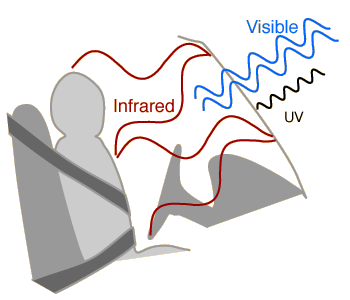 | Short wavelengths of visible light are readily transmitted through the transparent windshield. (Otherwise you wouldn't be able to see through it!) |
Shorter wavelengths of ultraviolet light are largely blocked by glass since they have greater quantum energies which have absorption mechanisms in the glass. Even though you may be uncomfortably warm with bright sunlight streaming through, you will not be sunburned.
Increase in Greenhouse GasesThe increase in the concentration of carbon dioxide, one of the three major atmospheric contributers to the greenhouse effect has been carefully documented at the Mauna Loa Observatory in Hawaii. The 1990 rate of increase was about 0.4% per year. The interesting cyclic variations represent the reduction in carbon dioxide by photosynthesis during the growing season in the northern hemisphere. Current analysis suggests that the combustion of fossil fuels is a major contributer to the increase in the carbon dioxide concentration, such contributions being 2 to 5 times the effect of deforestation (Kraushaar & Ristinen). Increase in Atmospheric Carbon Dioxide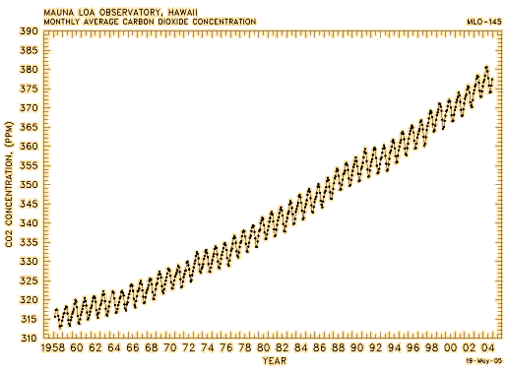 The Mauna Loa monitoring station reports the carbon dioxide level in the atmosphere today as about 380 parts per million compared to 315 ppm in 1958 when modern measurements were initiated. Measurements of air bubbles trapped in the Greenland ice sheet indicate concentrations of 270 ppm in preindustrial times.
| Index References Kraushaar & Ristinen Trefil | ||
Contributers to Greenhouse Effect
Those gas molecules in the Earth's atmosphere with three or more atoms are called "greenhouse gases" because they can capture outgoing infrared energy from the Earth, thereby warming the planet. The greenhouse gases include water vapor with three atoms (H2O), ozone (O3), carbon dioxide (CO2), and methane (CH4). Also, trace quantities of chloro-fluoro-carbons (CFC's) can have a disproportionately large effect.

To attempt to quantify the effects of greenhouse gases on the global temperature, climatologists use the "radiative forcing" of the current atmospheric content of these gases.
Global Warming
An issue of major concern is the possible effect of the burning of fossil fuels and other contributers to the increase of carbon dioxide in the atmosphere. The action of carbon dioxide and other greenhouse gases in trapping infrared radiation is called the greenhouse effect. It may measurably increase the overall average temperature of the Earth, which could have disastrous consequences. Sometimes the effects of the greenhouse effect are stated in terms of the albedo of the Earth, the overall average reflection coefficient.
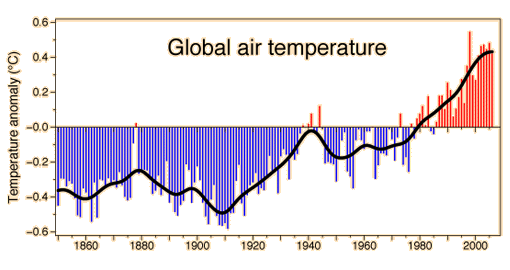
This graphic of the global air temperature was posted by Phil Jones on behalf of the Climatic Research Unit, UK. The key reference used was Brohan, et al.
Another depiction of the mean temperatures in the northern hemisphere was drawn from NOAA.
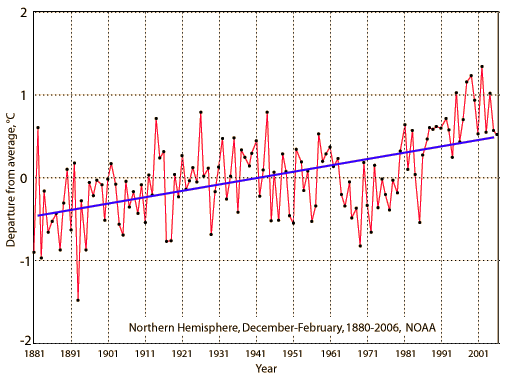
Essentially any kind of tabulation you access will tell the same story. The temperature has gradually risen over the last 150 years.
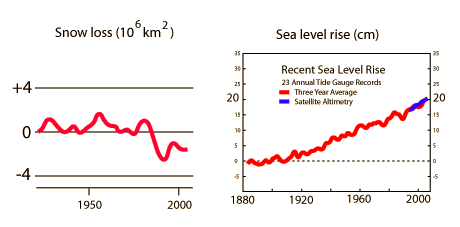
Because the potential consequences of global warming in terms of loss of snow cover, sea level rise, change in weather patterns, etc are so great, it is a major societal concern. On the other hand, proposed measures to reduce human contributions to greenhouse gases can also have great consequences. The large potential impact combined with the ambiguities of the science has given rise to many passionate extremes.
Stephen Schneider of Stanford seems to me to be one of the more balanced voices. His website is a good source for relevant data. He discusses the problems in the context of the Earth's energy balance and the changes in the concentrations of greenhouse gases.
Modeling Human Impact on Global Warming

This data on global temperature and efforts to model it is from Emanuel , MIT climatologist, published in the Boston Review. Since global warming is evident, the question of whether that warming is driven by human activities is of utmost importance. The data above show the observed temperature along with two computer simulations of that temperature, one including those influences arising from human activity and the other not. It can be seen that the two computer models diverge in the 1970s and now do not overlap. Emanuel comments "almost all climate scientists today believe that manÕs influence on climate has emerged from the background noise of natural variability."
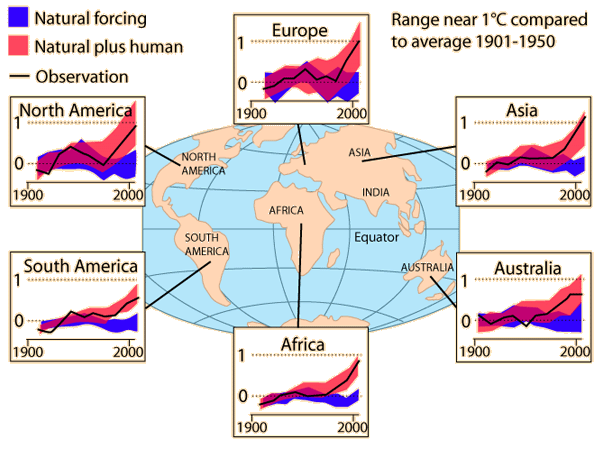
This illustration is constructed with data from Collins, et al., which in turn comes from the IPCC 2007 report. It is clear that the observed warming affects all continents, and that the models that include radiative forcing from human activities predict the observations better.
Source : http://hyperphysics.phy-astr.gsu.edu/hbase/thermo/grnhse.html#c2



Tidak ada komentar:
Posting Komentar